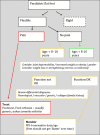Screening for foot problems in children: is this practice justifiable?
- PMID: 22827998
- PMCID: PMC3464168
- DOI: 10.1186/1757-1146-5-18
Screening for foot problems in children: is this practice justifiable?
Abstract
Podiatry screening of children is a common practice, which occurs largely without adequate data to support the need for such activity. Such programs may be either formalised, or more ad hoc in nature, depending upon the use of guidelines or existing models. Although often not used, the well-established criteria for assessing the merits of screening programs can greatly increase the understanding as to whether such practices are actually worthwhile. This review examines the purpose of community health screening in the Australian context, as occurs for tuberculosis, breast, cervical and prostate cancers, and then examines podiatry screening practices for children with reference to the criteria of the World Health Organisation (WHO). Topically, the issue of paediatric foot posture forms the focus of this review, as it presents with great frequency to a range of clinicians. Comparison is made with developmental dysplasia of the hip, in which instance the WHO criteria are well met. Considering that the burden of the condition being screened for must be demonstrable, and that early identification must be found to be beneficial, in order to justify a screening program, there is no sound support for either continuing or establishing podiatry screenings for children.
Figures




References
-
- Staheli LT. Evaluation of planovalgus foot deformities with special reference to the natural history. J Am Podiatr Med Assoc. 1987;77:2–6. - PubMed
-
- Evans AM, Rome K. A Cochrane review of the evidence for non-surgical interventions for flexible pediatric flat feet. Eur J Phys Rehabil Med. 2011;47:69–89. - PubMed
-
- Wilson JMG, Jungner G. Principles and practice of screening for disease. 34. World Health Organisation, Geneva; 1968.
Publication types
LinkOut - more resources
Full Text Sources
Miscellaneous

